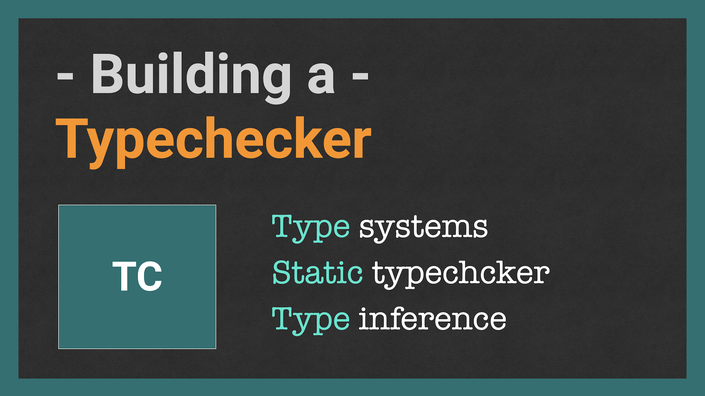
Building a Typechecker from scratch
Essentials of Type checking and Inference
Course overview
Untyped programs are often prone to errors, runtime exceptions, and can make debugging much harder. That’s why many production languages implement a static typechecker — an extra module, which is aimed to increase programs safety and make development simpler.
Type checking or type inference? What is Type theory and Type judgements? Is my language weakly or strongly typed? And how am I actually going to implement a typechecker?
There are so many questions when it comes to implementing this module. If you’ve been asking those questions in implementing your programming language, or just want to understand how typeckechers work under the hood, on a hands-on practical implementation, this course is for you.

Often related books on Type theory and type judgements go to theoretical aspects viewing types as mathematical sets, not explaining how actually to build a practical typechecker. I believe we should be able to build and understand a typechecker for a full programming language, end-to-end, in 2-4 hours — with a content going straight to the point, showed in live coding sessions as pair-programming and described in a comprehensible way.
In the Building a Typechecker from scratch class we focus specifically on a static typechecker, and build a similar to TypeScript, Java, etc. We slightly touch Type theory and already since the first lecture go into the practical implementation.
Implementing a typechecker would also increase your engineering level, as it touches several aspects of data structures and algorithms.

Prerequisites
An optional prerequisite for this class is the Building an Interpreter from scratch (aka Essentials of Interpretation) course, where we build an AST-interpreter for a full programming language. Unless you already have understanding of how programming languages work at this level, i.e. what eval, a closure, a scope chain, environments, and other constructs are — it is recommended to take the interpreters class as a prerequisite.
Who this class is for?
This class is for any curious engineer, who would like to gain skills of building complex systems (and building a typechecker for a programming language is an advanced engineering task!), and obtain a transferable knowledge for building such systems.
If you are interested specifically in compilers, PL and Type theory, and want to build a typechecker module for your programming language, this class is also for you.
What is used for implementation?
Sometimes people think that to build a typechecker you certainly need to use some programming language which is itself “very related to types and type theory” (such as OCaml of other functional programming languages). But actually no! You can build a fully working typechecker in plain JavaScript, and cover all the aspects of the Type systems. And this is exactly what we use for implementation.
JavaScript, being the most popular programming language, should be accessible for many engineers, and also our goal is to provide a simple and concise implementation, not focusing on specifics of a host language. So the code should be portable to any language of your taste and choice: TypeScript, Rust, OCaml, C++, Python, etc.
Note: we want our students to actually follow, understand and implement every detail of the Typechecker themselves, instead of just copy-pasting from final solution. Even though the full source code for the typechecker is presented in the video lectures, the code repository for the project contains /* Implement here */ assignments, which students have to solve.
What’s specific in this class?
 The main features of these lectures are:
The main features of these lectures are:
- Concise and straight to the point. Each lecture is self-sufficient, concise, and describes information directly related to the topic, not distracting on unrelated materials or talks.
- Animated presentation combined with live-editing notes. This makes understanding of the topics easier, and shows how the object structures are connected. Static slides simply don’t work for a complex content.
- Live coding session end-to-end with assignments. The full source code, starting from scratch, and up to the very end is presented in the video lectures
What is in the course?
The course is divided into four parts, in total of 20 lectures, and many sub-topics in each lecture. Below is the table of contents and curriculum.

Your Instructor

Dmitry Soshnikov is a Software engineer, and a lecturer on different computer science topics.
He is passioned about education, and focuses on high-quality educational content: concise and straight to the point animated lectures with live-editing notes.
You will learn:
- Compilers and interpreters: building a Programing language
- Garbage Collectors (Automatic memory management)
- Theory of programming languages
- Automata Theory: Building a RegExp machine
- Parsers theory: Implementing a Parser Generator
Course Curriculum
-
PreviewLecture 1: Introduction to Type theory and checking (19:38)
-
PreviewLecture 2: Typing Numbers and Strings. Testing (4:17)
-
PreviewLecture 3: Math binary operations | String concat (6:45)
-
PreviewLecture 4: Variables and Typing Environment, Г (8:16)
-
StartLecture 5: Blocks and Local scope (6:54)
-
StartLecture 6: Parsing: S-expression to AST (7:30)
-
StartLecture 7: Control flow: If and While expressions (7:24)